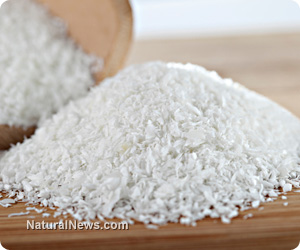It's not difficult to find research lamenting the poor nutritional value of enriched white flour. Consuming this omnipresent flour - which has been processed, bleached and stripped of all its nutrients - has been repeatedly linked to constipation, diabetes, cancer and more. Often, these conditions are related to white flour's notoriously high concentrations of gluten, which negatively affects the health of most people - not just those with gluten intolerance or celiac disease.

Fortunately, we don't have to give up baked foods to remain healthy. A growing number of nutritious and gluten-free alternatives to white flour are available to purchase online or in health food stores, and several of them maintain (or improve upon) its taste and texture. The best of them are listed below.
Coconut flour
Coconut flour is a sweet-tasting, low-GI (glycemic index) flour derived from coconut meat. Though it doesn't taste strongly of coconuts, it does contain all their health benefits. For example, one tablespoon of coconut [url]
http://www.dreddyclinic.com/forum/viewtopic.php?f=19&t=33158[/url] flour contains a whopping 10 grams of fiber, which is double the amount of fiber as wheat bran and 20 times as much fiber as white flour. Coconut flour is also high in protein and low in fat. Long-term consumption of it has been linked to reduced blood pressure and blood sugar, improved thyroid function, increased energy and even boosting testosterone levels.
Though its clumpy texture might take some getting used to, baking with coconut flour is fun, and many recipes accommodate it. That said, coconut flour is best-suited for baked desserts such as muffins, pancakes and waffles. You can find a big list of coconut flour recipes here http://www.freecoconutrecipes.com/gluten_free_coconut_flour_recipes.htm.
Buckwheat flour
Buckwheat flour is a gluten-free flour ground from buckwheat http://dreddyclinic.com/forum/viewtopic.php?f=18&t=32595, an Asian fruit plant with edible, triangular seeds. It has a pronounced, earthy taste and a fine texture. Like coconut flour, buckwheat flour is healthier than white flour in every aspect. It is high in fiber and protein (including all eight essential amino acids), rich in trace minerals like magnesium and copper, low in fat and calories, and contains two flavonoids - quercetin and rutin - which protect us from cell inflammation and damage.
Though versatile, buckwheat flour is best-known for its legendary pancakes http://dreddyclinic.com/forum/viewtopic.php?f=18&t=26349.
Mesquite flour
Mesquite is a deciduous tree that is native to the Americas, including the southern United States. It bears highly nutritious seed pods which, in turn, make an equally nutritious flour that is characterized by its pleasant, molasses-like taste.
Mesquite flour contains a similar health profile to coconut and buckwheat flour. Firstly, it is gluten-free, fiber-rich and comprised of approximately 13-17 percent protein, including the eight essential amino acids. Secondly, it is low in fat and carbohydrates and has negligible effects on blood sugar levels. Lastly, it is packed full of essential minerals, including magnesium and the ever-important calcium. Consequently, consumption of mesquite flour has been linked to weight loss, reduced blood sugar and blood pressure levels, and improved energy and moods.
Mesquite flour can add a punch to smoothies, cooked and raw desserts, and milk-based drinks. More adventurous cooks might be interested in making some cacao and mesquite flour "paleo balls http://drmichelleronan.wordpress.com/2012/10/22/cacao-and-mesquite-paleo-balls/," which make great pre-workout snacks.
Sources for this article include:
http://alldayidreamaboutfood.com/2013/04/low-carb-basics-baking-with-coconut-flour.html
http://wholegrainscouncil.org/whole-grains-101/buckwheat-health-benefits
http://www.onegreenplanet.org/vegan-food/mesquite-powder-health-benefits-tips-and-recipes/
http://www.dreddyclinic.com/forum/viewtopic.php?f=19&t=33158
http://dreddyclinic.com/forum/viewtopic.php?f=18&t=32595
About the author:
Michael Ravensthorpe is an independent writer whose research interests include nutrition, alternative medicine, and bushcraft. He is the creator of the website, Spiritfoodshttp://spiritfoods.net/, through which he promotes the world's healthiest foods.
Read more

